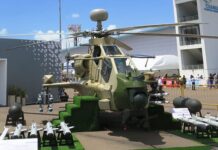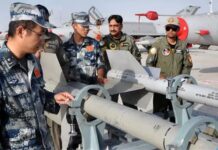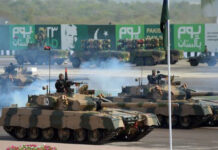Near Space Could be the New Battlefield
A Chinese spy balloon, a surveillance device, after flying for several days over US territory, was finally shot down, on 4 February, over the country’s territorial waters, off the coast of South Carolina. Almost around the same time as the balloon was shot down, the US also cancelled Secretary of State Antony Blinken’s scheduled trip to China.
In addition, the United States announced that balloons of a similar type had been seen flying over India, Taiwan, Japan and some other places. For its part, Beijing maintained claimed that the object was a weather balloon and denied charges of spying. It also said that US balloons entered Chinese airspace 10 times last year, which the US denied. The Chinese government accused the U.S. of overreacting, and signalled that it views the response as a sign of American decline.
Since 10 February, at least three more ‘unidentified flying objects’ were detected over North American airspace. The first was initially seen flying along the coast of Alaska. US F-22 fighter aircraft were scrambled to pursue it and shoot it down near the Arctic. This object was said to be silvergrey in colour and about the size of a small car. According to reports, the object did not appear to be propelled by a motor or any other device but was ‘floating’ in the atmosphere.
Then on 11 February, another object, smaller than but similar in shape to the Chinese spy balloon, was shot down over Canada’s Yukon territory by US fighter aircraft after the approval of the Canadian prime minister. On 12 February, another object was detected over the Great Lakes region and shot down over Lake Huron in Michigan. This object was reportedly hexagonal in shape.
The US did not blame China directly for the three ‘objects’, but given that they appeared so soon following the Chinese spy balloon the implication was that those might all be a part of the same campaign to collect sensitive data about the United States and its military installations. Beyond obtaining surveillance information, the objects, if at all they are Chinese, could also be decoys meant to gauge just how long any intruding craft would have before being shot down by US fighter jets.
Why was F-22 used?
The F-22 Raptor, using a $400,000 AIM 9X Sidewinder missile, scored its first “air-to-air” combat kill. Many observers questioned the need of using such an expensive jet to take down something relatively harmless, such as a high-altitude balloon. The balloon’s altitude might have had something to do with the decision. Among the fighters the U.S. possesses, the F-22 has the highest service ceiling and is the most capable of conducting a precision strike at those heights. The F-22 fired the Sidewinder at the balloon from an altitude of 58,000 feet. The balloon at the time was between 60,000 and 65,000 feet.
Why Balloons?
Balloons are much cheaper than spacecraft to launch and operate. Unlike satellites, they can loiter over a specific ground target. Even countries with advanced radar systems have a difficult time detecting them depending on the materials used for the balloon and the size of the sensor array.
The Chinese balloon exceeds the size, payload and flight time of normal weather balloons. It has been described as 200 feet tall, with solar panels and a surveillance payload the size of a regional jet, weighing more than 2,000 pounds.
According to the U.S. government, the Chinese balloon payload consisted of “multiple antennas to include an array likely capable of collecting and geolocating communications,” suggesting that the main purpose of the balloon was signals intelligence. Balloons can be used for several potential intelligence missions.
Messaging. China has a longstanding practice of communicating its political positions through military tests, exercises, diplomats, social media posts, state-owned media, businesses, think tanks, academics, and covert influence campaigns. This balloon flight, on the eve of a visit by the U.S. Secretary of State, could have been China’s effort to show strength.
Intelligence.
• Intercept High Frequency (HF) communications.
• Intercept downlink between satellites and ground station.
• Sensor Drop. By dropping autonomous gliders outfitted with sensors to
• Collect cellphone communications.
• Collect detailed atmospheric data.
• High resolution imaging.
• Dispense bioweapons.
The Ramifications for Beijing
The public attitude in the US has shifted its opinion and China now presents a clear danger. In an election year, presidential candidates will need to advocate increasingly hardline policies on China as the U.S. moves into the 2024 election cycle. Washington’s blacklisted six Chinese entities who were involved in the production of the collection platform. Washington leveraged the event to build global awareness of Chinese intelligence activities among allies and partners. The U.S. stated it shared information with at least 40 countries.
Balloons in Wartime
PLA writings have called near space the “new battlefield.” Chinese balloons have overflown more than 40 countries across 5 continents through the upper reaches of the Earth’s atmosphere, below the orbits of satellites but above the altitude of most winged aircraft. Intelligence gathering may not even be the most worrisome activity in the new battlefield.
High-altitude spy balloons appear to fill a gap in the PLA’s strategic intelligence, surveillance, and reconnaissance (ISR) capabilities.
The Chinese do have the world’s second largest fleet of satellites, after the United States. With nearly 600 satellites in orbit, 229 of them ISR satellites, China’s space program is likely its main source of strategic surveillance. But fear of the U.S. military taking out its satellites during an armed conflict, could have led to using high-altitude balloons as a backup to a degraded space-based remote sensing system.
Unlike satellites in low Earth orbit that revolve around the globe every 90 minutes, the balloons can loiter over a location for long periods of time. This allows for extended views of the target or time to monitor communications or other electronic signals, such as those emitted by radar.
PLA researchers have writen about near-space vehicles, possibly including high-altitude balloons, as kinetic strike platforms.
Balloons can also act as decoys to exhaust enemy air defenses in swarm operations that require the defender to use expensive missiles and aircraft to down them. Balloons can be used offensively in electronic warfare and psychological warfare missions.
Comments
It was not the first time ‘unspecified flying objects’ had been observed over the United States. At the end of 2022, the Pentagon said that such objects had been seen over American airspace or by military aircraft numerous times over the past several decades. Most have no explanation and have varying descriptions and are perhaps not unlike the ones seen recently.
China blatantly violated U.S. sovereign territory and unlike the shadowy world of espionage, it did so in full view of the American public.
The first large balloon was a People’s Liberation Army (PLA) intelligence asset. It is unlikely the four other objects detected over North American air space were Chinese collection platforms. However, the Pentagon confirmed that on four previous occasions, Chinese spy balloons conducted missions over the U.S.
Beijing badly miscalculated by violating U.S. airspace, particularly on the eve of Secretary of State Blinken’s visit. U.S. and foreign intelligence and law enforcement officials have labeled China the world’s greatest intelligence threat. China has publicly threatened the U.S. not to escalate the situation with an “overreaction.” Beijing will continue to react loudly and make counter accusations if Washington displays the intelligence collection hardware before the American public and the world. The Biden administration is caught between China’s threats to let the matter drop, and the public and Congress demanding to know more.
The spy balloon episode also exposes the domain of “near space” as a new arena of strategic competition that the U.S. did not fully realize was in play. It’s a battlefield that U.S. military planners may need to consider in future military operations.
IAF’s Experience with Aerostats
Following the recommendation of the Kargil Review Committee, the IAF had purchased two aerostats — also known as the Tethered Aerostat Radar System or TARS — for surveillance at a cost of over Rs 300 crore in 2007. While the balloon itself was American, there was a lot of Israeli equipment on board.
Aerostats are fitted with long-range radars, signal intelligence systems and meteorological instruments, among others. While military radars do have the ability to operate at long distances, being high in the air allows them to beat the limitations of the Earth’s curvature and other surface blocks.
The aerostat has the ability to pick up all take-offs and landings or large-scale military movements within a range of 100-600 km, depending on the kind of equipment on board and weather conditions. If the weather is bad, it has to be brought down. If there is cloud or smog, the radars do not work effectively.
After the first two, Aerostats have moved much further down in the IAF’s list of priorities. The IAF has been upgrading the equipment on board the aerostat from time to time and is looking at indigenous systems. The IAF feels that the answer to continuous surveillance is more airborne early warning and control aircraft (AWACS).
Wind conditions are not favourable for India to deploy spy balloons, since wind direc tion is generally west to east, i.e. from Pakistan towards India. China also cannot deploy spy balloons targeting India unless they are operated from Pakistan.
It is reported that atmospheric modeling and smart algorithms can allow a balloon to change altitude and to catch wind in any desired direction, and even to circle around a given point on the ground.


















